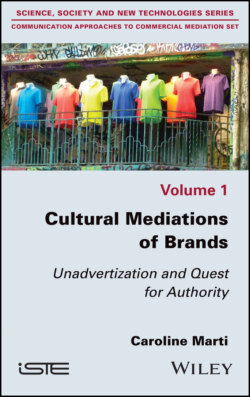Читать книгу Cultural Mediations of Brands - Caroline Marti - Страница 17
I.4.2. The particular modalities of a cultural mediation
ОглавлениеWhy does the adoption of a cultural position make it possible to build authority for brands? Beyond the discourse on the hypermediatization of brands and the actual and incessant quest for new modes of expression, beyond the idea, although currently major, of a brand positioning established not only on offers and the expression of values, but also on communicational innovation, a major question arises: how does cultural mediation14 constitute a particularly valuable relational model for brands seeking authority?
It prefigures what brands can play in the social space; it is a preferred means of putting into circulation, a means of developing a collective consciousness and of playing a political sociability with the institutions that structure the life of the city (Lamizet 1999).
This game in the public space is characteristic of the brands’ ideal life. Communicative in essence, they are semiotic instances reconverted into mediating instances, because they are intended to link the singular and the collective and to specify links with social groups, to symbolize a relationship with the world. Brands are configured by the expressive modes chosen by the professionals who manage them and which they use in the public space. The stakes are high: that of claiming the place that can be attributed to them in this space, described by Lamizet as “a place in which all the symbolic mediations of belonging are inscribed in forms of communication and representation” (Lamizet 1999, p. 110).
Communicators adopt, for the brands they manage, paths traced by others to make their voices heard. Thus, by engaging in collective forms of representation of social and cultural belonging, brands seem to be aimed at audiences rather than at customers or potential customers. This communicative conversion is characteristic of the cultural figurations taken into account for this research. The objective is neither to draw an exhaustive picture15 nor to extract a typology allowing for classifying the different modalities16.
By seeming to assume the role of cultural mediator, brands contribute to the circulation of cultural forms and the structuring of the relationship to knowledge in society. This perspective of the circulation of knowledge is major in the development of authoritarian forms, with cultural control and domination being strongly affected by this dynamic.
I have identified three main modes of cultural figuration that seem to me to be very revealing and significant in the quest for brand authority. They correspond to three communication modes, three operating instruments, three types of cultural mediation. To avoid any confusion, we could say that they cover symbolic mediations of contemporary knowledge: media mediations, didactic mediations and brand heritage mediations.
Informing, training, and institutionalizing are three major regimes of enunciation and characteristics of brand authority positions. They involve focusing on several levels of analysis: political, social, cultural and semiotic.
The order of enumeration of these three modalities corresponds to a gradation: to make this knowledge known, to disseminate it, to have it recognized as legitimate and to institute it. This process also chronologically overlaps with the ambition of brands when they are placed in the broader context of the history of commercial mediation. Each chapter will be an opportunity to question the representations of communication made by professionals from each perspective, recalling the logic behind the practices:
Any communicative practice is anticipated by a set of cultural constructs that are based on representations and norms, and also on incorporated movements; any device is both a configuration of the conditions of the exchange and a scene where it will be represented; the characteristic of these devices is to provide a framework for exchanges, but also to create an opportunity for engagement and action. In short, a communication situation is prefigured, constituted as a device, but it takes or does not take according to the way in which the subjects invest it (Jeanneret 2014, p. 192).
